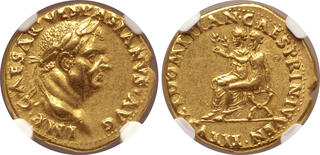| Roma Numismatics Ltd > Auction XXX | Auction date: 21 March 2024 |
| Lot number: 428 Price realized: 20,000 GBP (Approx. 25,336 USD / 23,327 EUR) Note: Prices do not include buyer's fees. | Show similar lots on CoinArchives Find similar lots in upcoming auctions on |
| Lot description: Vespasian AV Aureus. Lugdunum, AD 71. IMP CAESAR VESPASIANVS AVG, laureate head to right / TITVS ET DOMITIAN CAES PRIN IVVEN, Titus and Domitian seated to left on curule chairs, each holding a branch. RIC II.1 -, cf. 1318 (denarius); C. 543 var. (obv. legend); BMCRE -; Biaggi -; Calicó -. 7.27g, 19mm, 6h. NGC graded Ch XF 4/5 - 4/5 (#6944528-001). Struck from dies of fine style and preserved with beautifully lustrous metal. Unpublished and seemingly unique - a remarkable addition to the corpus of Flavian coinage. This unpublished aureus provides an illuminating insight into the relationship between the emperor Vespasian and his sons Titus and Domitian and his desire to establish the legitimacy of his new Flavian dynasty. The implied emphasis on a linear succession, highlighted by the depiction of his two sons on the reverse of this coin is particularly pertinent from a historical perspective, given that Titus' succession of Vespasian in AD 79 represented the first occasion since the inception of the principate by Augustus that a biological child had been the successor to an emperor. Vespasian, having been sent to Judaea by Nero in AD 66 to put down the Jewish rebellion, was joined by Titus, by now a tried, tested and capable commander who brought his own legion to support the existing troops. Josephus describes in vivid detail the taking of the city of Taricheae by Titus, who he says was the first to enter the city ahead of his men, his boldness taking those guarding the walls by surprise and allowing his forces to overwhelm them, to the delight of his father (The Wars of the Jews, III.10.5-6). During the chaos that ensued at Rome after the death of Nero in AD 69, Titus was sent to pay Vespasian's respects to the new emperor Galba, although he never reached Rome as he learned en route that Galba was already dead at the hands of Otho, with Vitellius preparing to march on Rome. Titus therefore abandoned the journey and rejoined his father in Judaea; he was then the crucial interlocutor (Tacitus, Histories, II.5) between Vespasian and the Syrian governor in negotiations that gained the military support of the governor of Syria, Gaius Licinius Mucianus. This provided Vespasian with the necessary forces to emphatically defeat the third new emperor of the same year, Vitellius, and ascend to the purple in December of AD 69. Titus was left in Judaea in AD 69, entrusted with bringing an end to the Jewish rebellion, thus freeing Vespasian to march on Rome. After his success at the siege of Jerusalem he returned to Rome, arriving in AD 71, which coincides with the date for the striking of this coin. He was received with much acclaim and fanfare, and his father immediately appointed him to several positions within the state, including those of consul and Praetorian Prefect, the latter giving him authority over the Praetorian guard. Both he and his brother Domitian were furthermore confirmed in the rank of Caesar, to which they had already been appointed, and received the honorific of Princeps Iuventutis. While Domitian was 12 years Titus' junior and therefore had been less able to demonstrate the same military and diplomatic abilities as his brother by the time Vespasian came to power, he was nevertheless promoted simultaneously with Titus. This decision to show no outward favouritism appears to be reflected by the iconography of this coin, which depicts them as equals: they are both seated on curule chairs, which had been long-associated with offices of power, despite the fact that in reality Domitian's official roles as Caesar and Praetor were only nominal and did not represent the wielding of any significant control. It is clear, however, that Vespasian was eager to represent both his sons as worthy successors. Estimate: 12500 GBP |  |


